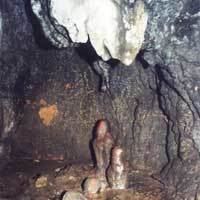 | ||
18 patal bhuvaneshwar pithoragarh
Patal Bhuvaneshwar is a limestone cave temple 14 km from Gangolihat in the Pithoragarh district of Uttarakhand state in India. It is located in the village Bhubneshwar. Legend and folklore have it that this underground cave enshrines Lord Shiva and thirty three koti Gods (33 types of gods in hindu culture). The cave is 160 m long and 90 feet deep from the point of entrance. Limestone rock formations have created various spectacular stalactite and stalagmite figures of various hues and forms. This cave has a narrow tunnel-like opening which leads to a number of caves. The cave is fully electrically illuminated. Built by the flow of water, Patal Bhuvaneshwar is not just one cave, rather a series of caves within caves.
Contents
- 18 patal bhuvaneshwar pithoragarh
- Map of Patal Bhuvaneshwar Uttarakhand 262522
- Paatal bhuvneshvar cave
- Legend Of the Cave
- History
- Inscription outside the Temple
- Places to visit
- References
Map of Patal Bhuvaneshwar, Uttarakhand 262522
"He who wants to feel the presence of eternal power should come to the sacred Bhuvneshwar situated near the confluence of Ramganga, Sarayu and Gupt-Ganga." -Manaskhanda, Skandapuran, whose 800 verses refer to Patal Bhuvaneshwar
Paatal bhuvneshvar cave
Legend Of the Cave
The first human to discover this cave was Raja Ritupurna who was a king in Surya Dynasty who was ruling Ayodhya during the Treta Yuga. The story starts with Ritupurna and King Nala. It is said that once, King Nala was defeated by his wife, Queen Damayanti. In order to escape his wife’s prison Nala requested Ritupurna to hide him. Ritupurna took him to the forests of the Himalayas and asked him to stay there. While going back home he was fascinated by a deer which ran into woods and went after it. He could not find it and took rest under a tree. He had a dream where the deer was asking Ritupurna not to chase him. His sleep broke and as he woke up and went to a cave where a guard was standing. After enquiring about the cave he was allowed to go inside. Right at the entrance, Ritupurna met Sheshnag who agreed to take him through the cave. It carried him on its hood. He saw the marvels of Gods taking place inside. He all the 33-koti (33 types of god not 33 cror ) gods and goddesses including Lord Shiva himself. It is said that after his visit, the cave was closed for ages with a slight prediction in the Skandpurana that it will be reopened again in Kaliyuga. Shankarcharya in Kalyug, during his visit to Himalayas re-discovered this cave. Since then regular worship and offering are being done at this place.
History
According to belief King Rituparna of the Sun dynasty (Surya Vansha) discovered the cave in ‘Treta yug’. It has been described in the ‘MANAS KHAND’ of ‘SKAND PURAN’. Adi Shankaracharya visited this cave in 1191 AD. That was the beginning of the modern pilgrimage history, at Patal Bhuvaneshwar. The journey inside the cave has to be carried in feeble lights, holding protective iron chains. The Stone formations of Sheshnag can be seen, holding earth, heaven the world beneath. ‘Havan’ (fire sacrifice) is performed in a dimly lit, solemn atmosphere, under the spell of holy chants. You’ll also be impressed by theto visit these parts form the celestial heights of His abode in Kailash.The cave, it is believed, is connected by an underground route to Mount Kailash. it’s believed that Pandavas, the ‘Mahabharat’ heroes proceeded towards their last journey in the Himalayas after meditating here, in front of Lord Shiva.This hidden pilgrimage situated at 1,350mts above sea level is mainly dedicated to Lord Shiva.Almost every god that you would have heard of resides in this mystifying cave. It is also believed that you can worship at Patal Bhuvaneshwar is equivalent to worshipping at Char Dham of Uttarakhand.
The priest family, the Bhandaris are performing religious rites at Patal Bhuvaneshwar since the time of the Adi Shankaracharya. More than 20 generations in the line. They are a treasure house of legends, lores, anecdotes and information about this holy place. It is also believed that this cave is internally connected to the four abodes /seats (Char Dham).
Inscription outside the Temple
"This awesome cave is believed to be as old as the earth itself. It has been mentioned in detail in the 103 chapter of Manaskhand of "Skanda Purana". The first human who entered this cave was king "Rituparna" of Suraya Dynasty during the "Tretayuga". It is said that during his visit, he had encountered several demons and "Sheshnaag" himself acted as his guide.One can see the gateway of the great ages in Patal Bhuvaneshwar. There are four entrances inside the cave named as ‘Randwar’ ‘Paapdwar’, ‘Dharamdwar’ and ‘Mokshadwar’. The Paapdwar was closed soon after the death of Ravana and the Randwar, literally, the road to war, was closed down after the great Mahabharata war. At present only two gateways are opened. You can see the tongue of Kali Bhairav, Aravati of Indra, hairs of Lord Shiva and several other wonders inside the caves of Patal Bhuvaneshwar.
In "Dwaparyuga" this cave was rediscovered by the Pandavas. In Kaliyuga, Adishankar Acharya consecrate this cave and since 1191, this has been a place of visit, both for sightseeing and worship."
Places to visit
The motorable road ends half a kilometer away from the cave entrance. You have to descends nearly 100 steps into this narrow cave, to reach the sanctum sanctorum, which gives an overwhelming feeling that you’re entering the centre of the earth.
Each stone, each stalagmite within each cave or doorway, in magnificent erection reveals the story of Hindu pantheon in the shapes of Gods, Goddesses, saints and known mythological characters.
